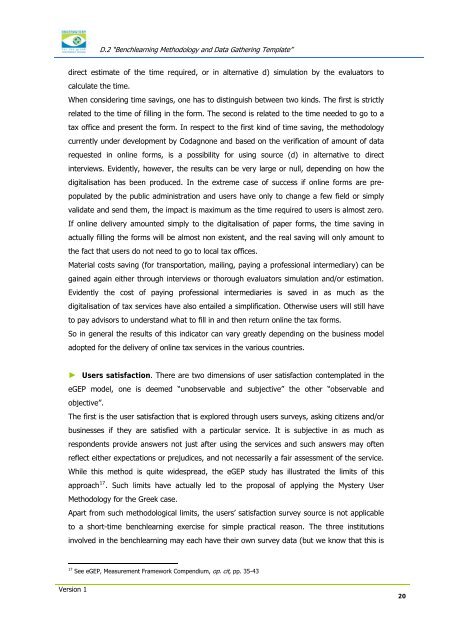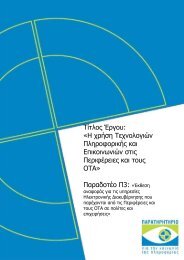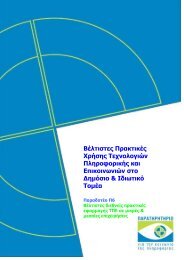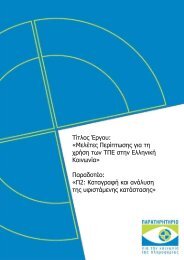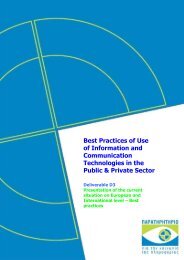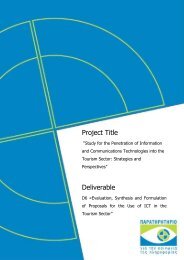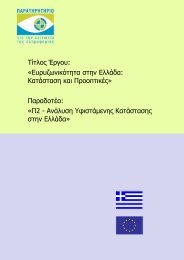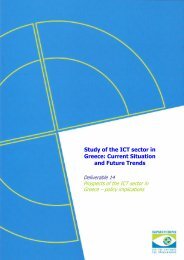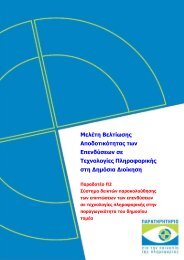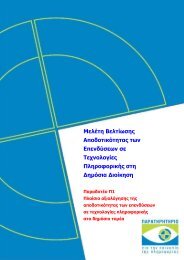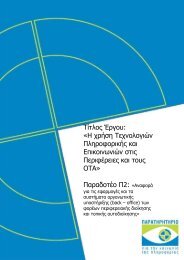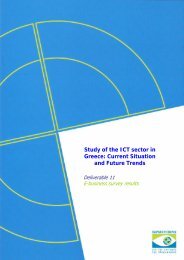Benchlearning methodology and data gathering template
Benchlearning methodology and data gathering template
Benchlearning methodology and data gathering template
- No tags were found...
You also want an ePaper? Increase the reach of your titles
YUMPU automatically turns print PDFs into web optimized ePapers that Google loves.
D.2 “<strong>Benchlearning</strong> Methodology <strong>and</strong> Data Gathering Template”direct estimate of the time required, or in alternative d) simulation by the evaluators tocalculate the time.When considering time savings, one has to distinguish between two kinds. The first is strictlyrelated to the time of filling in the form. The second is related to the time needed to go to atax office <strong>and</strong> present the form. In respect to the first kind of time saving, the <strong>methodology</strong>currently under development by Codagnone <strong>and</strong> based on the verification of amount of <strong>data</strong>requested in online forms, is a possibility for using source (d) in alternative to directinterviews. Evidently, however, the results can be very large or null, depending on how thedigitalisation has been produced. In the extreme case of success if online forms are prepopulatedby the public administration <strong>and</strong> users have only to change a few field or simplyvalidate <strong>and</strong> send them, the impact is maximum as the time required to users is almost zero.If online delivery amounted simply to the digitalisation of paper forms, the time saving inactually filling the forms will be almost non existent, <strong>and</strong> the real saving will only amount tothe fact that users do not need to go to local tax offices.Material costs saving (for transportation, mailing, paying a professional intermediary) can begained again either through interviews or thorough evaluators simulation <strong>and</strong>/or estimation.Evidently the cost of paying professional intermediaries is saved in as much as thedigitalisation of tax services have also entailed a simplification. Otherwise users will still haveto pay advisors to underst<strong>and</strong> what to fill in <strong>and</strong> then return online the tax forms.So in general the results of this indicator can vary greatly depending on the business modeladopted for the delivery of online tax services in the various countries.► Users satisfaction. There are two dimensions of user satisfaction con<strong>template</strong>d in theeGEP model, one is deemed “unobservable <strong>and</strong> subjective” the other “observable <strong>and</strong>objective”.The first is the user satisfaction that is explored through users surveys, asking citizens <strong>and</strong>/orbusinesses if they are satisfied with a particular service. It is subjective in as much asrespondents provide answers not just after using the services <strong>and</strong> such answers may oftenreflect either expectations or prejudices, <strong>and</strong> not necessarily a fair assessment of the service.While this method is quite widespread, the eGEP study has illustrated the limits of thisapproach 17 . Such limits have actually led to the proposal of applying the Mystery UserMethodology for the Greek case.Apart from such methodological limits, the users’ satisfaction survey source is not applicableto a short-time benchlearning exercise for simple practical reason. The three institutionsinvolved in the benchlearning may each have their own survey <strong>data</strong> (but we know that this is17 See eGEP, Measurement Framework Compendium, op. cit, pp. 35-43Version 120


